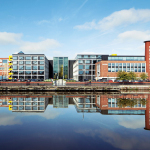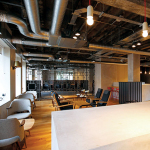Every strong brand, like every good building, needs a story.
If the Northern Powerhouse wants to tell a tale of industry, advanced technology, creativity and entrepreneurship, then it should look to its history to sell that message. From the red brick walls of Victorian mill buildings to the concrete-clad chimneys of abandoned factories, the cities of the North are well-placed to respond to the global occupier demand for exposed bricks and humanised workspaces. Can they be cost-effective too?
EG looks at the conversions across the North that are spearheading the trend.
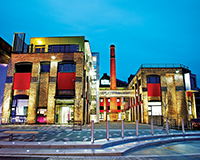 Toffee Factory, Newcastle upon Tyne
Toffee Factory, Newcastle upon Tyne
Developer: 1NG with Carillion Igloo
Occupiers: 24 small- and medium-sized digital and creative businesses
The drive to regenerate derelict old buildings has in many cases been spearheaded by the public sector where private developers have been put off by the associated risks and liabilities.
The Toffee Factory in Newcastle’s Ouseburn is a case in point.
The shell of the Victorian sweet factory had been left abandoned since 1993 when the building was severely damaged by fire.
After repeated attempts to get developers interested in the site, including negotiations with Bellway Homes and Miller Homes, the council finally decided to set up its own development company in 2010.
1NG, a joint venture between Newcastle City Council, Gateshead Council and ONE, the government’s regional development agency for the North East, secured funding for the £5m redevelopment of five sites around the Toffee Factory with selected development partner Carillion Igloo.
The development includes 29,000 sq ft of office space that has attracted 24 digital, media and creative companies.
Neil Armstrong, co-founder of design and media consultancy 55 Creatives, which leases space in the Toffee Factory, says he was prepared to pay the comparatively higher rents to other council start-up spaces because of the atmosphere and image it presented to clients. “I suppose it is that combination between the historic and the new and the fact that it is a sustainable building which attracted us,” he says.
The building is currently fully let, with quoted rents of £24.50 per sq ft.
Ged Bell, Newcastle City Council’s cabinet member for investment and development, says the scheme has given developers confidence to progress with their own regeneration proposals in the Ouseburn Valley while creating much-needed space for creative and digital businesses.
“We know that providing opportunities for the creative and digital sector to collaborate and share skills and resources is vital to attracting and developing these businesses,” he says.
No.1 Aire Street, Leeds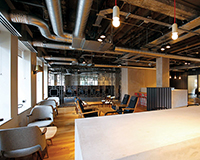
Developer: Network Rail Property & The Office Group
Occupiers: Small- and medium-sized digital businesses including Publish Interactive – creators of a software platform for publishing and hosting interactive market research reports online.
Network Rail Property represents the next wave of public sector heritage development opportunities, as government departments are instructed to sell off assets.
In Leeds, a 1930s art deco railway office next to Leeds station has been converted into 12,500 sq ft of co-working space for start-up The Office Group.
The office provider entered into a joint venture with Network Rail Property, hiring architecture and interior design practices Fuse Studios and Gensler in 2014 to retain the character of the grade II listed building by leaving as much as possible of the building structure exposed.
The result was a workspace of oak floors under exposed ceiling soffits, ducts and cable trays. Bricks and concrete columns line the building’s co-working space, five meeting rooms, 1,200 sq ft club room and roof terrace.
Charlie Green, co-chief executive of The Office Group, says it would be more difficult to attract companies to take desks in a glass and steel traditional office building. “The building sells itself, it has its own story,” he says. “I think we would struggle to get occupiers into a more modern building.”
The Office Group charges £335-350 per month for a desk and has reached close to full capacity. It is planning to expand the offices by a third into adjoining Network Rail Property space.
While there were complications working with a historic building, Green says it was also a very “cost-effective” conversion through the recycling of existing features and materials.
Network Rail, which plans to dispose its £1bn arches portfolio of commercial property near railway stations by 2020, says it will “always look to preserve and enhance heritage assets” even if it is sometimes “quicker and cheaper to demolish and rebuild buildings”.
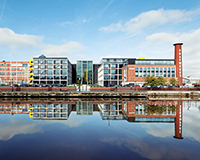 Soapworks, Salford, Greater Manchester
Soapworks, Salford, Greater Manchester
Developer: Carlyle Group, Nikal and Abstract Securities
Occupiers: TalkTalk, Home Office, MWH Global
The regeneration of the former Colgate Palmolive factory was one of the first in a wave of projects which emerged following the 2008 market crash.
Soapworks manager Jennifer Bamber said the original decision to recycle the old building during the recession was partly driven by cost saving.
However, Carlyle Group has since found that the large floorplates and sense of identity that comes with the building’s industrial features has attracted major occupiers such as TalkTalk, which has signed for 126,000 sq ft, and the Home Office, which is fitting out 54,000 sq ft.
“When it was a building site, everyone thought it would struggle to let,” Bamber says. Now, they are struggling to meet demand with 90% of the building let and rents driven up from £15 per sq ft to £19-19.50 per sq ft.
JLL Manchester’s head of city centre development, Tom McWilliams, says the benefits of legacy buildings is largely their role as place-making tools which, if used correctly, can act as a pull for occupiers across all sectors.
“We are encouraging developers to combine historic properties and new development, rather than start from scratch and are indeed seeing more and more do so,” he says.
Lingfield Point, Darlington
Asset manager: Clearbell
Occupiers: Amec Foster Wheeler, Student Loan Company, Capita, FaulknerBrowns, Four Seasons Health Care and Turtle Beach
Lingfield Point in Darlington was once the site of the largest wool factory in the world. It was built in the 1950s but gradually went into decline, closing in 1999.
The 1.5m sq ft of buildings on the 40-acre site was bought by Marchday in 1998 and converted into a business park comprising 243,000 sq ft of offices, of which 20,000 sq ft is vacant.
It was sold to Clearbell for £23.5m in November 2014.
The art deco Lingfield House at Lingfield Point was converted from the global headquarters of Patons and Baldwins to a multi-tenanted building – home to Amec Foster Wheeler, Four Seasons Health Care and a number of smaller businesses.
The remaining space comprises 1m sq ft of sheds, of which 100,000 sq ft could be converted into additional office space, and 14,900 sq ft of residential.
Clearbell director Dominic Moore says the primary attractions of the old buildings are their “sense of place” and “belonging in the town”.
He admits the costs of refurbishment could be quite high, but says infrastructure spending to improve connectivity at the site was the biggest cost overall.
“Once we do undertake the refurbishment, we try to future-proof them as much as we can,” he says. “They are old buildings but were built to last.”
Low rents of £12.50-£15 per sq ft and the availability of large floorplates with options to have a significant input on the design, layout and development of offices have also helped to draw occupiers, according to Tim Carter, director at Connect Property North East, who is joint letting agent on the scheme.
Architect’s view
In London, the shortage of warehouse stock is leading to developers such as Derwent at the White Collar Factory, EC1, actively trying to create an industrial aesthetic of high ceilings and lofty atmospheres. This presents an opportunity for the major cities of the North to capitalise on their stock of underused buildings, says architect Roger Hawkins of Hawkins\Brown, who has worked on numerous heritage schemes including the Rutland Mills in Wakefield, Yorkshire.
“I think through good planning, survey and structural investigation, you can easily work to derisk old buildings,” he says. “There is something dull about just a standard floorplate. If you are a tech start-up, technology is quite transportable and all you want is a nice place to work, and a historic building is just a nice place to be.”
To send feedback, email louisa.clarence-smith@estatesgazette.com or tweet @LouisaClarence or @estatesgazette







